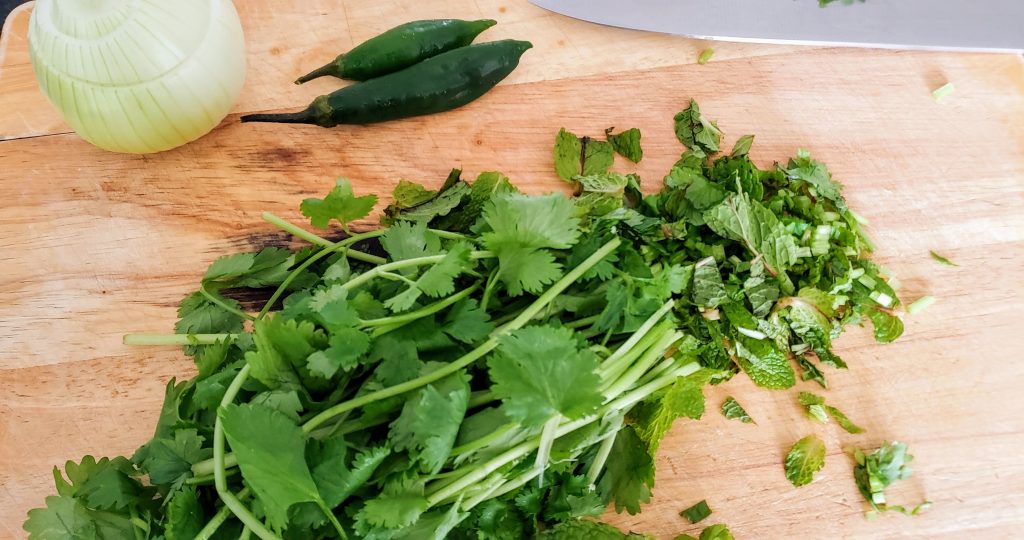This chutney is used as a relish during a meal, a condiment alongside pakodas (savory fritters) and samosas, a filling for Indian high tea finger sandwiches or as one of the sauces used in making Behl Puri (a diced salad with crisp, puffed rice). This chutney can be made with mint only (leaves only), coriander only (I use both leaves and stem whereas others use the leaves only) or a combination of the two. I like to mix the two herbs in equal amounts.
INGREDIENTS
- 1 bunch mint (leaves only), washed thrice
- 1 bunch cilantro, leaves and stem, washed thrice
- 2 onions, chopped coarsely
- 1-2 hot chili peppers, chopped coarsely – optional
- juice of 2 limes or lemons
- salt to taste
INSTRUCTIONS
Separate the leaves from the stem of the mint (if you are right-handed) by firmly grasping the top of the stalk with your left hand and with your right hand, pinching the stalk just below the point where you grasped it and then pulling both hands away from one another while still holding the mint stalk. This is the fasted way to remove the leaves.
Cut off the roots of the cilantro and remove any spoiled leaves or soggy stems.
Wash both herbs thoroughly in a pot of water, don’t drain into a colander. Instead, fish the leaves and stems out of the water with your hands into a colander. Drain the water in the pot directly into the sink. This way, you will not reintroduce sand and dirt into the washed herbs. Repeat at least twice or until the water in the pot runs clean.
Chop the cilantro coarsely into 1-inch chunks.
Place washed and chopped herbs, chopped onions, hot chilis, lemon/lime juice, and salt into either a blender or food processor. Process until smooth. You may need to stop the machine and scrape down the sides.
Correct the salt and check to see if you need more lemon or hot chili. Process again until smooth.
Note *These ingredients may be purchased at your local Indian grocer. For this reason, I have given you the name of the spice both in English and Hindi as that is the name (written phonetically in the English alphabet) you will find it under when you go shopping.
Spices impart specific flavors and aromas that enhance the overall flavor of the dish when used correctly. Moreover, they have a lot of health benefits.
Pudina (mint) – Sharp. Mint is used in its dried form as a condiment. It is added to vegetable and meat gravies after the burner has been turned off. Its powdered form is used to season yogurt and made into a tisane. Its fresh form is used to make chutneys and spiced drinks (gol guppa da pani). Mint helps reduce nausea and reduces fever. It is high in antioxidants and contains menthol that not only breaks up phlegm and mucus but also relieves a sore throat. It is used to soothe your stomach and aids in digestion. However, in some people that suffer from acid reflux, it may worsen symptoms.
Dhania (fresh coriander) – Citrus-like, Soapy. Either you’ll love it or hate it. Both leaves and stems are used as a condiment and added to food at the end of cooking as decoration, an aromatic and a flavor enhancer. It is used all over Asia and in Latin America. It is made into chutneys and salsas. It is chopped and added to salads. It is baked as part of stuffing into bread such as parathas. It is added to vegetarian and meat dishes alike. Coriander may protect your heart by lowering blood pressure and LDL (bad) cholesterol while increasing HDL (good) cholesterol. It is an antimicrobial, antioxidant and reduces the symptoms of Irritable Bowel Syndrome such as bloating or gas.
Written by Anju Kapur of Anju’s Table. All content and images on this site are copyright protected. Please do not use any of my images without my permission. Should you wish to share this recipe on your site, please add a link to this post as the source.



[…] here to see the recipe for mint/coriander […]
[…] with potatoes and mashed vegetables, spiced meat, or spiced shredded chicken. They are served with mint/coriander chutney and/or tamarind chutney. They make a wonderful tea time snack or a hearty appetizer with […]